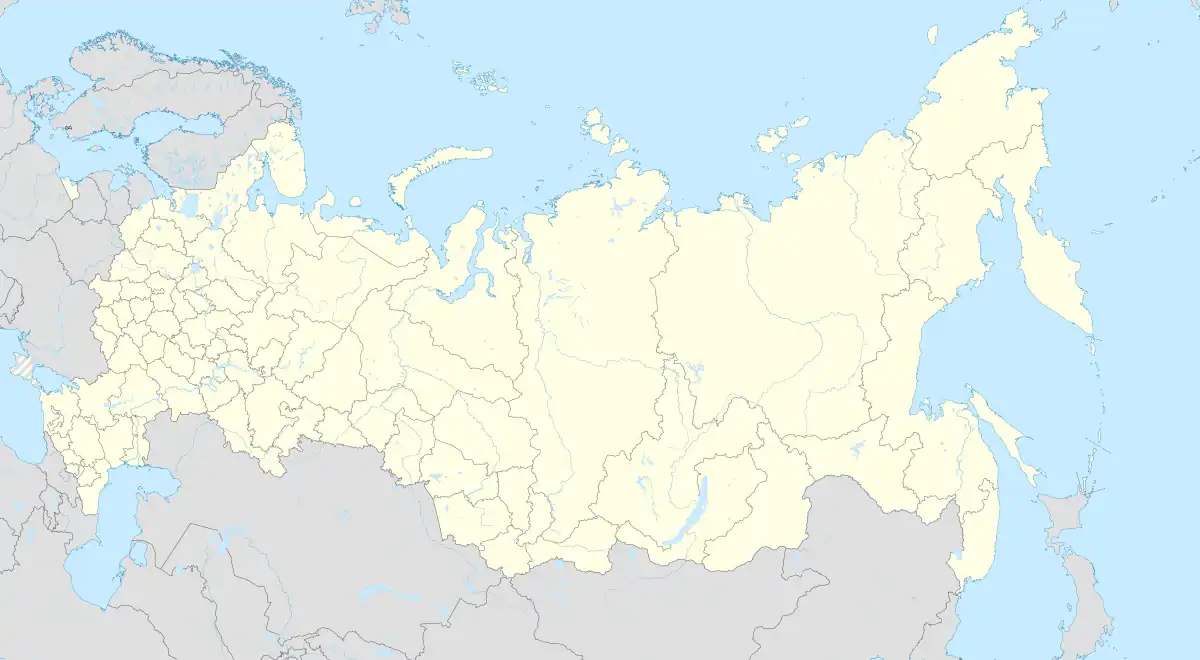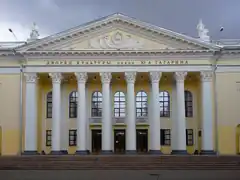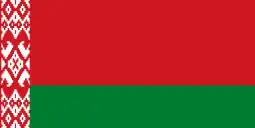Sergiyev Posad
Сергиев Посад | |
|---|---|
 Central part of the city with Trinity Lavra | |
.svg.png.webp) Flag .svg.png.webp) Coat of arms | |
Location of Sergiyev Posad | |
 Sergiyev Posad Location of Sergiyev Posad  Sergiyev Posad Sergiyev Posad (Moscow Oblast) | |
| Coordinates: 56°18′54″N 38°08′12″E / 56.31500°N 38.13667°E | |
| Country | Russia |
| Federal subject | Moscow Oblast[1] |
| Administrative district | Sergiyevo-Posadsky District[1] |
| City | Sergiyev Posad[1] |
| Founded | 1347 |
| City status since | 1782 |
| Government | |
| • Body | Council of Deputies[2] |
| Area | |
| • Total | 50.40 km2 (19.46 sq mi) |
| Elevation | 210 m (690 ft) |
| Population | |
| • Total | 111,179 |
| • Estimate (2018)[5] | 103,444 (−7%) |
| • Rank | 142nd in 2010 |
| • Density | 2,200/km2 (5,700/sq mi) |
| • Capital of | Sergiyevo-Posadsky District,[1] City of Sergiyev Posad[1] |
| • Municipal district | Sergiyevo-Posadsky Municipal District[6] |
| • Urban settlement | Sergiyev Posad Urban Settlement[6] |
| • Capital of | Sergiyevo-Posadsky Municipal District,[6] Sergiyev Posad Urban Settlement[6] |
| Time zone | UTC+3 (MSK |
| Postal code(s)[8] | 141300–141315, 141318 |
| Dialing code(s) | +7 496 |
| OKTMO ID | 46728000001 |
| Website | www |
Sergiyev Posad (Russian: Се́ргиев Поса́д, IPA: [ˈsʲɛrgʲɪ(j)ɪf pɐˈsat]) is a city that is the administrative center of Sergiyevo-Posadsky District in Moscow Oblast, Russia. Population: 111,179 (2010 Census);[4] 113,581 (2002 Census);[9] 114,696 (1989 Census).[10]
It was previously known as Sergiyev Posad (until 1919), Sergiyev (until 1930), Zagorsk (until 1991).
History

Sergiyev Posad is the religious center of the Moscow Region as its first monastery was founded in 1337.[11] The monastery began as a church built by Sergius of Radonezh, made out of wood, and by 1345 was recognized as a place of religious worship.[12] Town status was granted to Sergiyev Posad in 1742. In the 16th and 17th centuries, the religious center continued expanding into new monastery buildings, living areas, and stone walls, which withheld a Polish Siege of 1608–1610.[13] In the 18th century, wooden monasteries were mostly destroyed and began reconstruction and settlement (roads, hotels, stable, and hospice).[14] Lavra was closed in 1919 after the Russian Revolution, like all other places of worship in the USSR.[15] The town's name, alluding to St. Sergius, has strong religious connotations. Soviet authorities changed it first to just Sergiyev in 1919, and then to Zagorsk in 1930, in memory of the revolutionary Vladimir Zagorsky.[16] Sergiyev Posad was penetrated by Germany in 1941. It reopened later in 1941 during WW2 and continued to serve as a religious and historical center of Russia.
The original name was restored in 1991.
Administrative and municipal status
Within the framework of administrative divisions, Sergiyev Posad serves as the administrative center of Sergiyevo-Posadsky District.[1] As an administrative division, it is, together with twenty-six rural localities, incorporated within Sergiyevo-Posadsky District as the City of Sergiyev Posad.[1] As a municipal division, the City of Sergiyev Posad is incorporated within Sergiyevo-Posadsky Municipal District as Sergiyev Posad Urban Settlement.[6]
Culture
The culture of Sergiyev Posad focuses on its religious and toymaking history, as well as classical music and art.[17] The Sergiyev Posad State History and Art Museum-Preserve contain the Lavra complex of monasteries, and the Konny Dvor museum, which consists of art and excavated artifacts.[18] In addition to the Lavra monasteries, the Chernigovsky Skete was built as a men's monastery in the 19th century, providing space for over 400 monks.[19] Today, the Skete is quiet and peaceful, with only 10 monks coming to complete its everyday functions.[20]

The Russian wooden toys, matryoshkas, were invented there by an artist Sergey Malyutin, and are now displayed in the Toy Museum.[21] There are over 800 exhibits from the 11-21st century, including artifacts from other countries.[22] Because of the town’s deep-rooted focus on art and music, it has many schools for children, who are enrolled between the ages of 6–8 years old.[23] In addition, it is home to many such as which has been mentioned in War and Peace, Yuri Gagarin Palace of Culture which is a Russian Heritage Building.
Economy and transportation
Tourism associated with the Golden Ring plays a role in the regional economy. There is an important toy factory and Zagorsk Optical-Mechanical Plant.
The Moscow–Yaroslavl railway and highway pass through the town. Sergiyev Posad Bus Terminal is located in the city.
 Street in Sergiyev Posad by Aristarkh Lentulov
Street in Sergiyev Posad by Aristarkh Lentulov Kelarsky pond
Kelarsky pond Lavra Hotel
Lavra Hotel Yuri Gagarin Palace of Culture
Yuri Gagarin Palace of Culture
Notable people
- Andrei Rublev, artist, Church iconography, lived in the 14-15th centuries, author of Saint Trinity's icon
- Zhanna Bichevskaya, Soviet/Russian singer and folk musician
- Daniel Chorniy, artist, Church iconography, lived in the 14-15th centuries
- Pavel Florensky, Russian Orthodox theologian and researcher
- Vikentii Trofimov, painter
- Vladimir Favorsky, graphic artist, woodcut illustrator, painter[24]
- Aristarkh Lentulov, avant-garde artist
- Boris Kustodiev, painter
- Mikhail Nesterov, painter
- German Sterligov, businessman
Twin towns – sister cities
Sergiyev Posad is twinned with:[25]
 Cephalonia, Greece
Cephalonia, Greece Fulda, Germany
Fulda, Germany New Athos, Georgia
New Athos, Georgia Rueil-Malmaison, France
Rueil-Malmaison, France Saldus, Latvia
Saldus, Latvia Slonim, Belarus
Slonim, Belarus Vagharshapat, Armenia
Vagharshapat, Armenia
Former twin towns:
 Gniezno, Poland
Gniezno, Poland
In March 2022, the Polish city of Gniezno severed its ties with Sergiyev Posad as a response to the 2022 Russian invasion of Ukraine.[26]
References
Notes
- 1 2 3 4 5 6 7 8 Resolution #123-PG
- ↑ "Администрация городcкого поселения Сергиев Посад | Устав городского поселения Сергиев Посад Сергиево-Посадского муниципального района Московской области". Archived from the original on February 21, 2018. Retrieved June 11, 2015.
- ↑ Росстат. Регионы России. Основные социально-экономические показатели городов. 2010 г.
- 1 2 Russian Federal State Statistics Service (2011). Всероссийская перепись населения 2010 года. Том 1 [2010 All-Russian Population Census, vol. 1]. Всероссийская перепись населения 2010 года [2010 All-Russia Population Census] (in Russian). Federal State Statistics Service.
- ↑ "26. Численность постоянного населения Российской Федерации по муниципальным образованиям на 1 января 2018 года". Federal State Statistics Service. Retrieved January 23, 2019.
- 1 2 3 4 5 Law #60/2005-OZ
- ↑ "Об исчислении времени". Официальный интернет-портал правовой информации (in Russian). June 3, 2011. Retrieved January 19, 2019.
- ↑ Почта России. Информационно-вычислительный центр ОАСУ РПО. (Russian Post). Поиск объектов почтовой связи (Postal Objects Search) (in Russian)
- ↑ Russian Federal State Statistics Service (May 21, 2004). Численность населения России, субъектов Российской Федерации в составе федеральных округов, районов, городских поселений, сельских населённых пунктов – районных центров и сельских населённых пунктов с населением 3 тысячи и более человек [Population of Russia, Its Federal Districts, Federal Subjects, Districts, Urban Localities, Rural Localities—Administrative Centers, and Rural Localities with Population of Over 3,000] (XLS). Всероссийская перепись населения 2002 года [All-Russia Population Census of 2002] (in Russian).
- ↑ Всесоюзная перепись населения 1989 г. Численность наличного населения союзных и автономных республик, автономных областей и округов, краёв, областей, районов, городских поселений и сёл-райцентров [All Union Population Census of 1989: Present Population of Union and Autonomous Republics, Autonomous Oblasts and Okrugs, Krais, Oblasts, Districts, Urban Settlements, and Villages Serving as District Administrative Centers]. Всесоюзная перепись населения 1989 года [All-Union Population Census of 1989] (in Russian). Институт демографии Национального исследовательского университета: Высшая школа экономики [Institute of Demography at the National Research University: Higher School of Economics]. 1989 – via Demoscope Weekly.
- ↑ "Sergiyev Posad". Britannica.
- ↑ "Sergiev Posad History".
- ↑ "History of Trinity Sergius Lavra".
- ↑ "Architectural Ensemble of the Trinity Sergius Lavra in Sergiev Posad".
- ↑ "Attractions of Sergiev Posad".
- ↑
Compare: Ring, Trudy; Watson, Noelle; Schellinger, Paul, eds. (1996). "Sergiev (Moscow, Russia)". Northern Europe: International Dictionary of Historic Places. Routledge (published 2013). ISBN 9781136639517. Retrieved August 8, 2015.
Lenin's successor Stalin intensified religious persecution in the Soviet Union overall, and the situation perhaps became threatening enough to warrant the town to change its name in 1930 to Zagorsk, derived from the name of the Bolshevik revolutionary Vladimir Zagorsky, who was assassinated by rival socialists in 1919.
- ↑ "Sergiev Posad: An Introduction".
- ↑ "The Sergiev Posad State History and Art Museum-Preserve".
- ↑ "Chernihovsky Skit".
- ↑ "Chernihovsky Skete".
- ↑ "Around the City: Toy Museum".
- ↑ "Museum Information".
- ↑ "Public schools churning out future musicians and artists".
- ↑ Great Soviet Encyclopedia (3rd ed., 1977), vol. 27, p. 178
- ↑ "Побратимы Сергиева Посада". sergiev.ru (in Russian). Sergiev.ru. Retrieved February 4, 2020.
- ↑ "Gniezno zrywa umowę partnerską z rosyjskim miastem Siergijev Posad" (in Polish). Retrieved March 13, 2022.
Sources
- Губернатор Московской области. Постановление №123-ПГ от 28 сентября 2010 г. «Об учётных данных административно-территориальных и территориальных единиц Московской области», в ред. Постановления №252-ПГ от 26 июня 2015 г. «О внесении изменения в учётные данные административно-территориальных и территориальных единиц Московской области». Опубликован: "Информационный вестник Правительства МО", №10, 30 октября 2010 г. (Governor of Moscow Oblast. Resolution #123-PG of September 28, 2010 On the Inventory Data of the Administrative-Territorial and Territorial Units of Moscow Oblast, as amended by the Resolution #252-PG of June 26, 2015 On Amending the Inventory Data of the Administrative-Territorial and Territorial Units of Moscow Oblast. ).
- Московская областная Дума. Закон №60/2005-ОЗ от 28 февраля 2005 г. «О статусе и границах Сергиево-Посадского муниципального района и вновь образованных в его составе муниципальных образований», в ред. Закона №161/2011-ОЗ от 14 октября 2011 г. «О внесении изменений в Закон Московской области "О статусе и границах Сергиево-Посадского муниципального района и вновь образованных в его составе муниципальных образований"». Вступил в силу со дня официального опубликования. Опубликован: "Ежедневные Новости. Подмосковье", №42, 10 марта 2005 г. (Moscow Oblast Duma. Law #60/2005-OZ of February 28, 2005 On the Status and the Borders of Sergiyevo-Posadsky Municipal District and the Newly Established Municipal Formations Comprising It, as amended by the Law #161/2011-OZ of October 14, 2011 On Amending the Law of Moscow Oblast "On the Status and the Borders of Sergiyevo-Posadsky Municipal District and the Newly Established Municipal Formations Comprising It". Effective as of the day of the official publication.).